Anchoring: The solid basic equipment for dropping the hook with peace of mind
Hauke Schmidt
· 21.05.2024
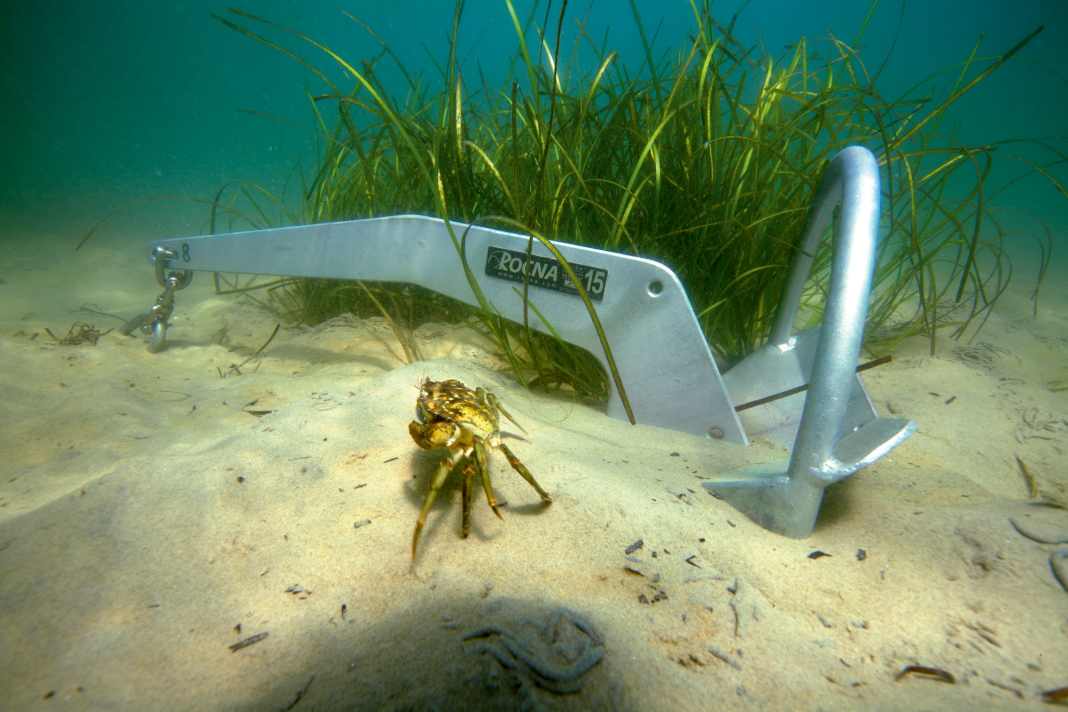





Text by Frank Reinecke and Hauke Schmidt
The fascination of cruising is not just about the time you spend at sea. When you drop anchor in a sheltered, ideally even secluded bay after an eventful trip, peace and quiet suddenly return. The yacht becomes an island. No annoying neighbours at berth. No noise from the harbour pub. No city noise in the background. Only the whisper of the wind and the gentle lapping of the waves against the hull can be heard. On the other hand, there is always a certain uncertainty. At the latest when the wind shifts or picks up, the question arises: Will the anchor hold? After all, you are not only entrusting the boat to it, but possibly also the life and limb of the crew.
So doubts are justified. Almost every skipper has experienced for themselves that the iron just doesn't want to find a hold when manoeuvring the anchor. It is then usually difficult to find the cause, as the decisive moments take place under water. Even if this is clear, the condition of the bottom can literally only be assessed superficially from on board. And when the anchor is being lowered, the yacht is 30 metres or more away.
Also interesting:
The crew can therefore only interpret the behaviour of the chain and line as well as the ship during and after the anchor manoeuvre. This requires a certain amount of experience. Of course, the anchoring equipment also plays an important role. All components of the anchoring gear must be able to withstand peak loads consisting of wind, waves and currents at all times. The typical trio of main anchor, anchor chain and anchor winch is used on the Bavaria 47 Ocean shown here as an example. A second anchor and a 50 metre anchor line are kept ready to hand in the forecastle if required.
Common proven anchor types
When selecting the anchor, the focus is on reliable burying and a secure hold. If the ground bar also fits into the existing bow fitting, all the better. If not, the fitting can be modified by an experienced stainless steel fitter.
Many cruising sailors use shackle anchors such as the Rocna, as they hold well on various anchoring surfaces and always turn back into the correct position under tensile load due to the shackle. This is a behaviour that plate anchors do not exhibit. If enough chain runs parallel to the ground and there is sufficient tension on the chain, a broken-out stirrup anchor reliably digs itself back in. In addition to the stirrup or spade anchor, there are numerous other types with a wide variety of advantages and disadvantages.
Plate anchor
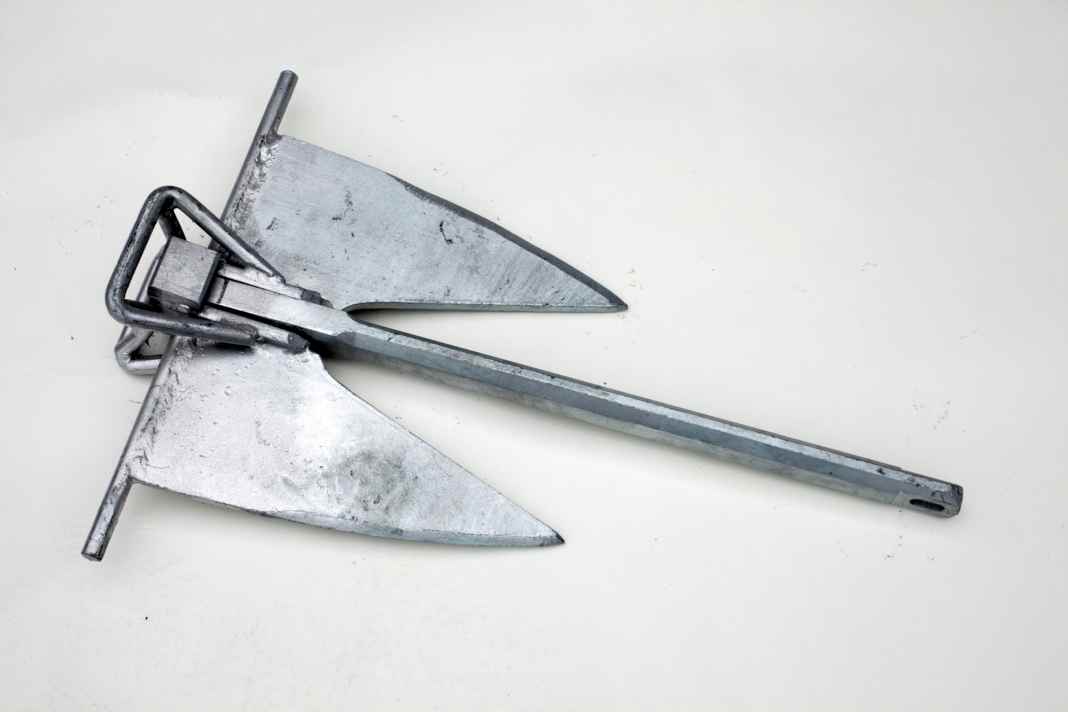



The articulated ground irons are inexpensive and easy to stow in the back box, they usually grip well on sand. The biggest problem is that the construction is not self-stabilising. If the anchor starts to move in the bottom, it is usually as good as broken out. Even small irregularities in the ground conditions or a changing angle of pull can cause the iron to tip on its side, a flukes then protrudes from the ground and the anchor breaks out sooner or later.
Ploughshare anchor
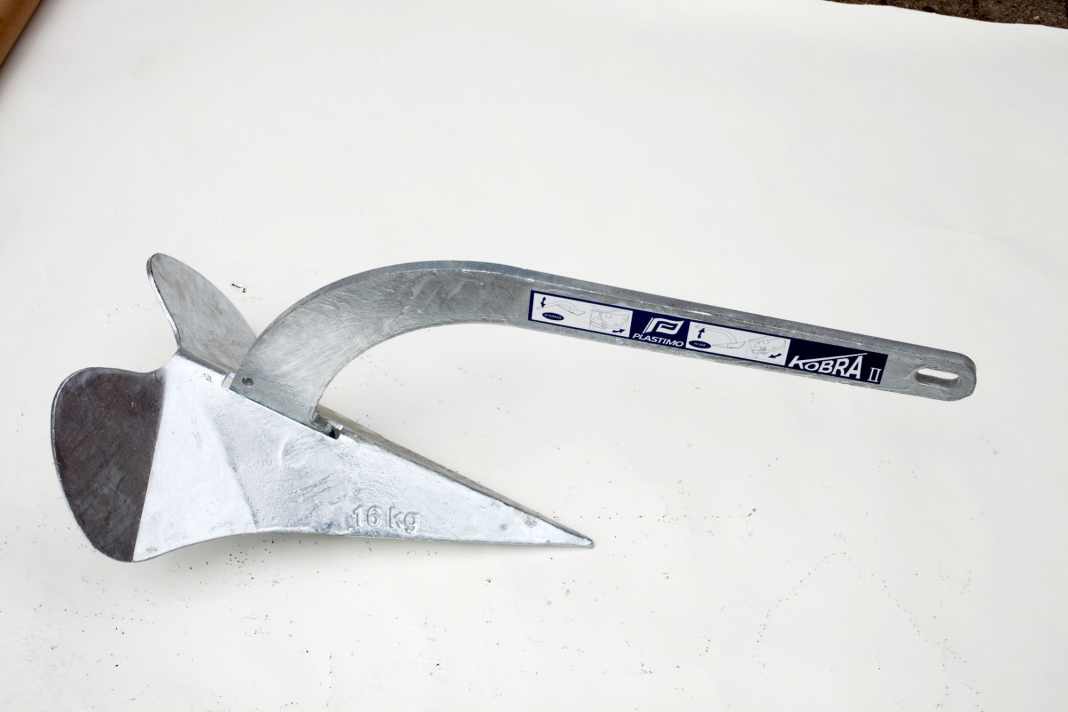



The plough shape automatically straightens the anchor and stabilises it. In addition, the anchor usually fits into the bow roller. The Cobra model from Plastimo was particularly impressive in the tests in YACHT 2/2006 and 17/2009, as it usually grabs hold as soon as it touches the ground and digs in very well. The iron is also very stable on the bottom and is comparatively inexpensive. There are various models on the market, not all of which work equally well. Versions with a joint are less recommendable.
Stirrup/spade anchor
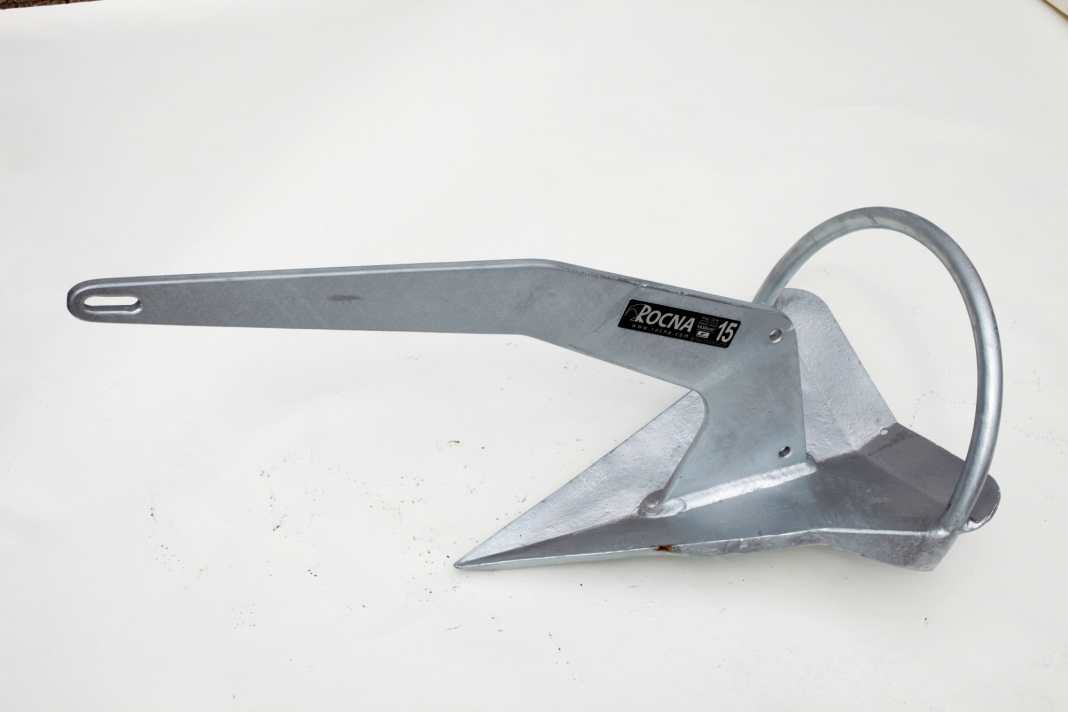


Depending on the design, a stirrup or the weight distribution helps to raise the anchor. As with the ploughshare anchor, the shape stabilises itself in the ground. The sharp point usually grips well. Models with a shackle are very easy to carry and are popular with long-distance sailors. However, there are many models on the market, some of which have very different behaviour despite barely visible differences. Some models only perform well on a sandy bottom, see YACHT 2/2006 and 17/2009.
Dimensioning of anchor, chain and hawser
In order for the anchor to fulfil its task, its size and weight must match the boat. The dimensioning is primarily based on the length of the boat and then on the displacement. The example boat has a length of 15 metres, a width of 4.45 metres and a weight of 13.7 tonnes. The total weight results from the net tonnage of 11.9 tonnes stated by the shipyard and the possible payload of 1.8 tonnes.



The anchor manufacturers and certification companies provide tables from which the appropriate anchor size can be taken based on the criteria described, see table.
Material & Corrosion
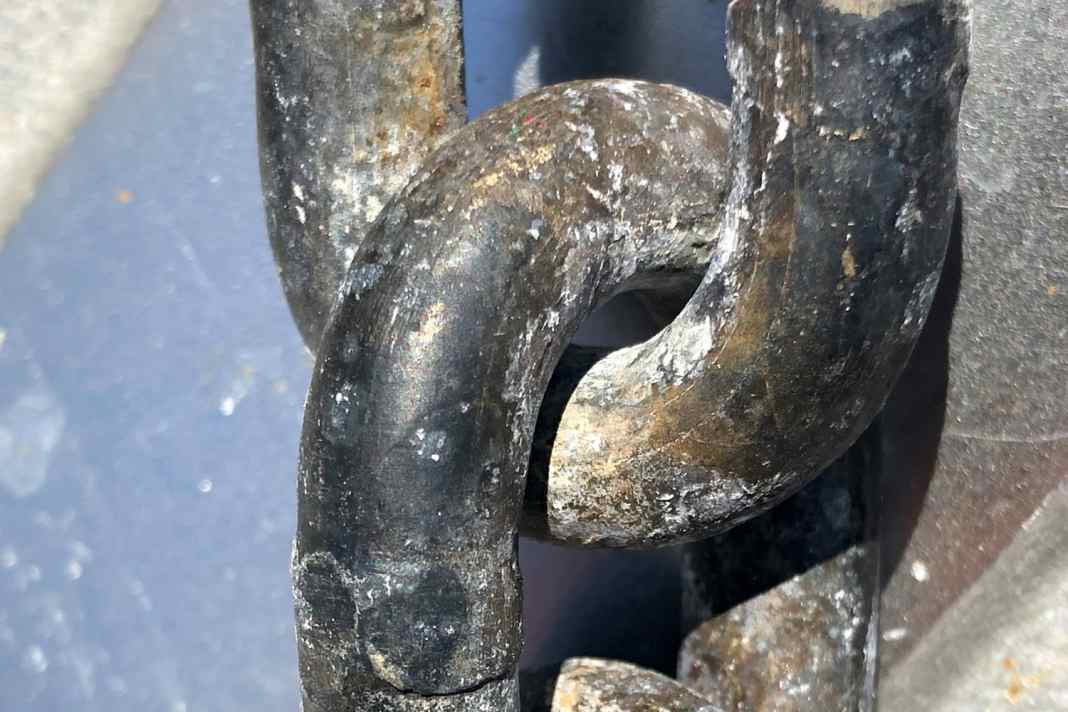



A word about securing to the bow: It is not recommended to drill a hole in the anchor shaft to secure it to the bow fitting. With hot-dip galvanised anchors, the protective surface is broken at this hole. This can also impair the breaking load of the iron.
The choice of material for the anchor and chain depends on the area. Warm waters, such as the Mediterranean or the Caribbean, are not ideal for stainless steel chains as they are very susceptible to corrosion. This mainly applies to chains with material numbers 1.4401 (AISI 316) and 1.4404 (AISI 316L).
Pitting and crevice corrosion form. The breaking load of a damaged chain is greatly reduced. These types of corrosion are difficult to see and there is no sign of chain breakage. If you still want to benefit from the advantages of a stainless steel chain, you should use duplex steel with the material number 1.4462 (AISI 318LN). This steel is best protected against corrosion due to its alloy. Corrosion is generally not an issue for the anchor itself, as there is sufficient material available. However, the price is three times that of a galvanised version.
To ensure that everything runs smoothly, the chain and the nut must fulfil the same standard
Corrosion is not critical for hot-dip galvanised anchors; they lose their zinc surface depending on use and begin to rust. Here, too, there is sufficient material so that the anchor can still be used for a long time even when rusted. In addition, a used base iron can be re-galvanised. With hot-dip galvanised chains, damage and corrosion are easy to detect. This is a major advantage. Sudden chain breakage is therefore not to be feared. The price per metre of a ten-millimetre duplex chain is around 60 euros, and it has a breaking load of 7.2 tonnes. In comparison, a hot-dip galvanised ten-millimetre chain costs around 13 euros per metre and has a breaking load of five tonnes.
Anchor chains are manufactured in Europe in accordance with ISO standard 4565. In Germany, the Din 766 standard applies. Outside Europe, chain dimensions can also be specified in inches. The two standards Iso and Din have different dimensions in relation to the chain links. To ensure that everything runs smoothly, the chain and the nut must fulfil the same standard. The standard and chain thickness are usually engraved on the chain nut. If not, it is safest to take the nut to a specialist dealer and check the fit of the chain.
The dimensioning of the anchor gear can be scientifically determined and calculated taking into account all influencing factors. However, there is no simple formula for this. The choice of chain strength on a pleasure craft is at the discretion of the owner. Here too, the recommendations of the classification societies can serve as a guide. However, they are often only based on the length of the boat or the displacement and do not take into account possible differences in windage. Here is a comparison: a Bavaria 47 Ocean with a centre cockpit and a length of 14.68 metres weighs 13.7 tonnes. A Moody 41 DS with deck saloon displaces 15.7 tonnes, but is only 12.52 metres long and also has a larger windage area. This means that the anchor gear must also be larger. The differences are even more extreme for catamarans and trimarans.
Connect & twist
Each chain strength has a specific working and breaking load. The dimensioning of the breaking load depends on the one hand on the wind load and on the other hand on the wave and current that set the boat in motion. This energy must be absorbed by the anchor chain through its spring effect. Enormous load peaks can occur. The equipment must be able to withstand these and at the same time the handling of the anchor gear must be taken into account. Dimensioning is therefore a balancing act between the strength of the anchor gear and the weight. One metre of 10 mm chain weighs 2.25 kilograms. With a length of 80 metres, this means a weight of 180 kilograms plus the weight of the anchor at 33 kilograms. This weight acts on the bow and must be taken into account when distributing the weight of the boat.
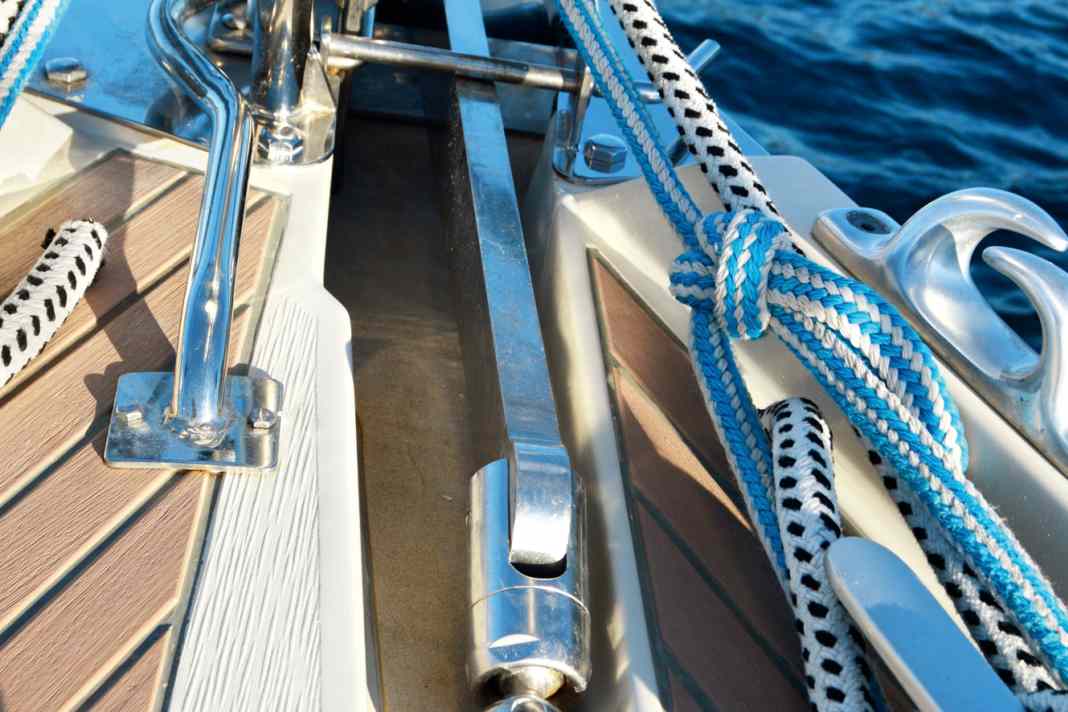



It is also important to ensure that all components of the harness are sufficiently stable. This applies in particular to the swivel between the anchor and chain. It has the task of untwisting a chain that has been twisted by swaying. Swivels are available in a wide variety of designs, but not all of them should be attached directly to the anchor. This is because without an additional joint, there is a risk of them being bent open when pulled sideways.
Use and storage determine the service life of the anchor chain, which should be checked regularly. If your boat has a deep and voluminous anchor locker with a drain at the bottom, you can count yourself lucky. In fact, there are series manufacturers who position the drain a few centimetres above the floor. This means that water and dirt are always left behind. These are not good conditions for storing the chain and should be rectified as a precaution.
The chain is laid out completely on the bridge for inspection and maintenance. Rust spots are inspected and removed with a wire brush. The contact points of the chain links in particular must be checked for wear.
What to consider with an anchor winch
A powerful anchor winch increases comfort and should always be on board when using a chain. The size of the winch depends on the weight of the anchor gear. The maximum pulling force of the winch should correspond to four times the weight of the anchor chain, anchor, swivel and shackle. The manufacturer's maintenance instructions must be followed to ensure that the winch can be used to its full capacity at all times. The electrical connections on the motor are susceptible to corrosion. These should be regularly maintained with pole grease. However, galvanic corrosion is also prevalent, as aluminium and stainless steel come into contact with each other. It is therefore necessary to regularly remove the windlass from the platform to remove dirt and salt crystals. It may also be necessary to re-grease the gearbox or change the oil.
Communication is just as important for breaking the anchor out of the bottom. If the iron has to be lifted out of the bottom with a taut chain when travelling slightly forward, the chain should not be held by the winch alone. It is better to catch the chain on the cleats with a chain claw and a capstan.
If it is possible for space reasons, a chain stopper, also known as a pawl, should be used on the bow fitting. The chain stopper has the task of allowing the chain to pass in one direction and blocking it in the other. The respective direction can be determined by flipping the locking plate.
The winch should also be relieved to allow the anchor to evaporate when reversing and during anchoring. A mooring line about five metres long with plenty of stretch and an additional rubber shock absorber is used for this purpose. It is ideal if the line can be laid directly over the anchor rollers. This will prevent the line from snagging when the boat is swaying.
Helpful equipment






The necessary anchor signals should not be omitted. These include the clearly visible anchor ball on the foredeck and the white all-round light. Thanks to LED technology, the power consumption of the anchor lantern is negligible. The use of a buoy to mark the anchor is also recommended. A small fender with a block attached to the end is also suitable for this purpose. The line then runs from the anchor through the block to a weight or a large shackle. This automatically adjusts to the water depth and the buoy is positioned directly above the anchor.
With the marker, it is much easier for later arriving anchors to estimate the swinging circle and you save yourself discussions. Another advantage of the buoy: If the line is dimensioned accordingly, the anchor can also be broken out in an emergency. Rope with a Dyneema core, for example, is suitable for this, as it easily provides the necessary breaking load and is still thin and supple.
You can now leave the anchor watch to the on-board electronics or smartphone with a clear conscience. The plotter usually offers a corresponding function. However, it is more convenient to use one of the many anchor alarm apps. The "Anchor Sentry" software has proven itself; it is available for Android and iOS devices and costs just under five euros. In addition to position monitoring and no-go zones, the orientation of the boat can also be monitored using a compass. This allows alarms to be programmed for wind shifts or the use of shore lines.
Particularly practical: as soon as an internet connection is available, the app can be mirrored to other devices. This allows you to turn your mobile phone into a daughter device when you go ashore and continue monitoring on the move. It is also possible to display and monitor the position of other "Anchor Sentry" users, allowing alarms to be triggered if the neighbouring boat drifts into your own wake. A secure power supply to the main unit is important for all app solutions. The tablet or smartphone at the navigation table should be powered from the on-board power supply, as constant position tracking via GPS shortens the battery life.
Speaking of swinging, modern yachts often tend to sail up and down the chain and run hard into the harness when the wind picks up. A so-called anchor sail helps against this. It is set on the backstay and shifts the boat's centre of pressure to the stern. This causes the yacht to align itself like a wind vane and lie more calmly in the wind. A storm jib set upside down can also be used for this purpose. However, it will be somewhat less stable than an anchor sail without a profile.
Correct anchoring requires more than a well-matched anchor harness. However, this is the first step. The selection of the anchorage, the length of the chain used and also the correct evaporation of the anchor into the bottom are important factors for a safe stay in an anchorage.

